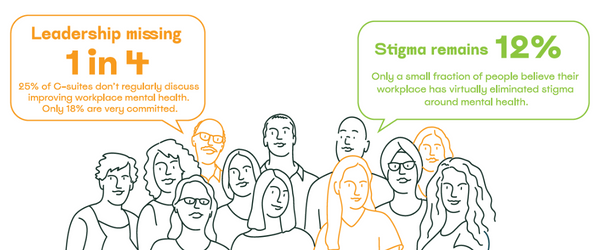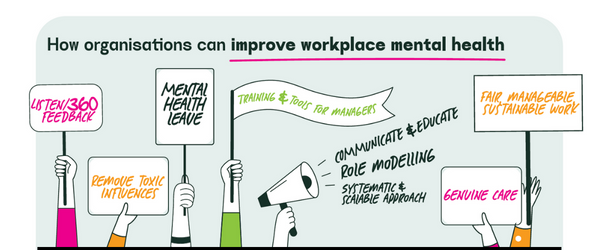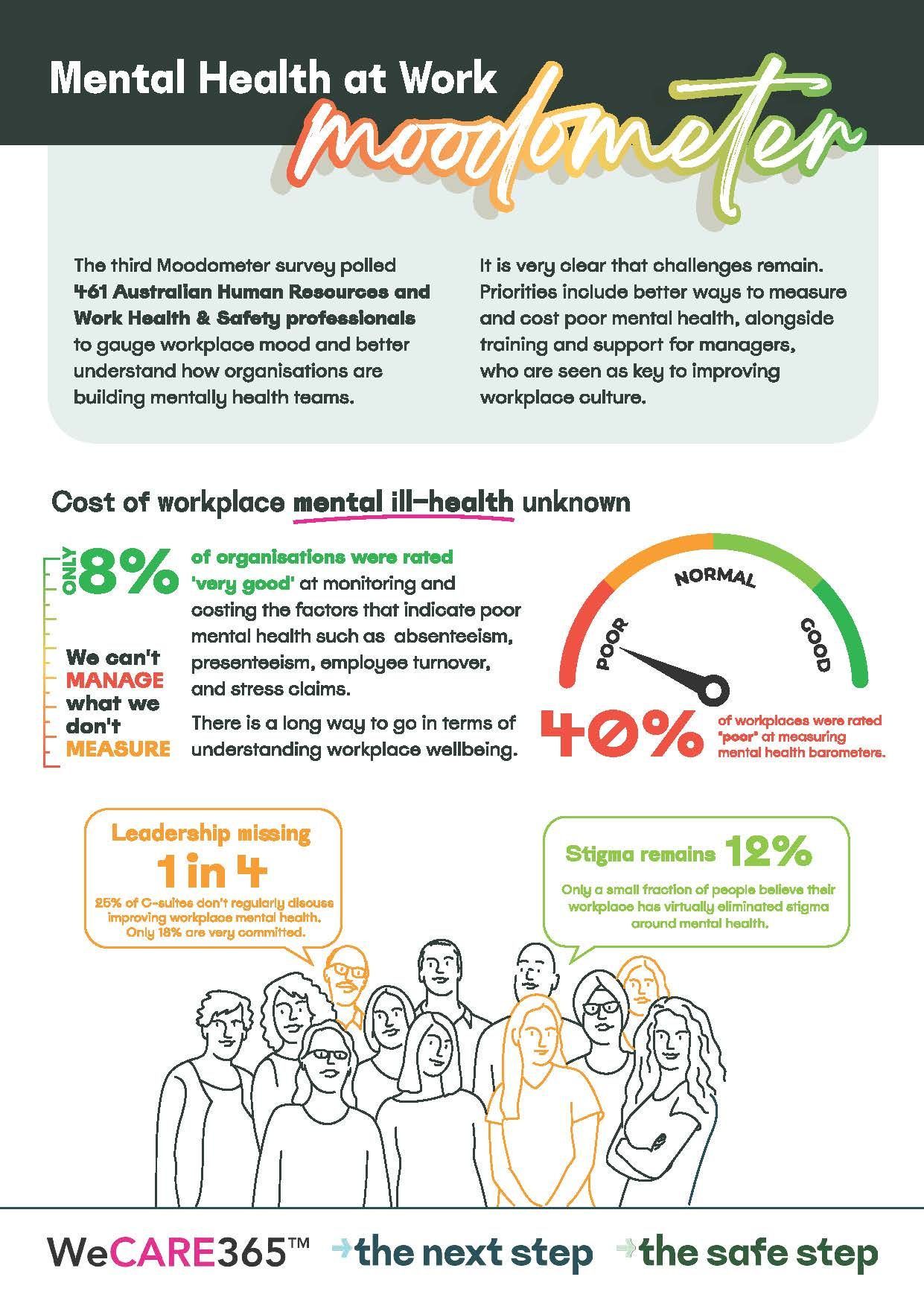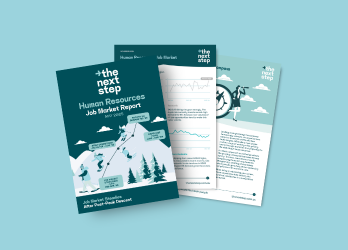Workplace mental health: 2023 pulse check
We surveyed a range of Australian HR and HSE professionals to gauge their workplace mood and to better understand how organisations are building mentally health teams. It is very clear that challenges remain.
Priorities identified in The Next Step's latest Mental Health at Work Moodometer include better ways to measure and cost poor mental health, alongside training and support for managers, who are seen as key to improving workplace culture. Read on to learn more.
Cost of workplace mental health unknown
Only 8% of leadership teams were rated 'very good' at monitoring and costing the factors that indicate poor mental health, such as absenteeism, presenteeism, employee turnover, stress claims etc.
Ringing alarm bells, 40% were judged 'poor' at measuring indicators of poor mental health within the workforce.
Mental health advocate, Graeme Cowan believes that having systems and processes to track key indicators is essential for managing risk. "We can't manage, what we don't measure." he explains.

Managers not up to the task
An alarming 44% of people say that most managers within their organisation don’t know how to build a mentally healthy team.
Providing specialist training and support to managers is considered to be one of the key ways organisations can improve positive mental health in the workplace. "There needs to be a consistent experience amongst staff of how managers deal with stress. Some are excellent but some are terrible," one respondent said. Another recommended, "Invest in building people leader capability, specifically inclusion and early intervention."
Genuine care was seen as curtail for making a difference. “Check in on a personal level. Rather than focus on the numbers at all costs,” one commented.
Listening was also seen as being very important. “Listen, work with the people & understand with empathy,” suggests a survey respondent. Improving the culture of feedback, two-way team communications and 360 reviews were also highlighted, with one professional suggesting. "Regularly seeking out the views, opinions and feelings of all employees on their mental health status. Checking in to ensure employees are mentally well and give them a chance to have a voice - especially if they are feeling vulnerable, concerned for a colleague or not travelling well in themselves."
Support for managers is top of mind for HR professionals looking to engage and retain their workforce. "Many organisations are investing in HR people who can help them shift mindset and develop modern middle managers, capable of building, coaching and caring for healthy, productive teams,” says Jo Skipper, Managing Director of The Next Step.
Leadership missing
Only 18% of C-suites are very committed to improving mental health. One in four C-Suites (25%) don't regularly discuss improving workplace mental health.
When asked to identify ways that organisations could do to support and/or improve positive mental health, strong alignment and prioritisation from executive leadership was seen as key.
“Board and CEO to set it as a priority. Equal to client care, is the safety and wellbeing of our people who deliver that care,” was the advice from one survey respondent. “Take a holistic top down approach and drive ownership further into operations rather than rely on the HSE team,” said another.

Stigma remains
Nearly a quarter of people (24%) encounter mental health stigma at work. Just over one in ten believe they have virtually eliminated stigma.
It's no surprise then, that communication, education and resources were identified as one of the top three ways organisations can improve workplace mental health.
“Talk about it! Says it ok to not feel ok,” says one survey respondent. "Understand it is a priority and invest in education and prevention rather than just paying for psych support to pick up the pieces at the end!” explains another.
Facilitating authentic, focused and guided discussions was seen as key for early intervention and mitigation. “Communicate that mental health matters and on practical level [provide] the supports and assistance available - opening up the channels on what is available for employees and who many need further help or support. [Provide] a consistent reminder to [people] on how and where they can get help," suggested one respondent.
12 ways to improve workplace mental health
Survey respondents identified a number of ways organisations can support and/or improve mental health in the workplace. Top priorities are:
- Listen to their workforce / seek 360 degree feedback
- Provide fair, manageable, sustainable work
- Communicate, educate & resource mental health initiatives
- Mental health training for managers & staff
- Remove toxic behaviour/influences from the organisation
- Take a planned, systematic & scalable approach to tackling mental health
- Provide mental health/wellbeing leave
- Approach the issue with a genuine care/make it personal (not about numbers)
- Measure & analyse mental health indicators
- Make it a priority for C-suite & ensure leadership alignment
- Provide flexible, autonomous work
- Create more quality face-to-face time for teams

Poor work culture
Nearly one third of people surveyed say that their workplace culture does not make them want to remain in their current job.
Jo Skipper, believes this is a challenge that can be turned into an opportunity with the right mindset. "What is more alarming? That 1/3rd of HR & HSE professionals say their workplace culture does not make them want to remain in their current job. Or that HR & HSE have the ability to influence and change culture in their roles – but that 1/3rd don’t see that as a possibility?" Skipper says.
Ringing warning bells for employers, one third of employees (34.4%) gave their organisation a rating of 50 or below on the Workplace Moodometer. The average mood of organisations was 59 out of 100, with 5% of all respondents saying their organisation was toxic, dysfunctional and ineffective.
“In the year ahead, many HR professionals believe that organisations must become as obsessed about employee experience as they are about customer experience,” says Jo Skipper.
Team mood
The Team Moodometer average rating sits at 65, placing it about ‘meh!’ status, but a long way from highly engaged and effective.
Whilst many teams indicated strong alignment with each other, just under a quarter of respondents (22.5%) believe their team mood is 50 of less, with 4.3% reporting they worked in a dysfunctional, toxic team environment.
Toxic behaviour and negative influences were key issues identified as damaging to workplace mental health.
“Since the new CEO came into the business the culture has changed, turnover has doubled and engagement dropped. Until there is change at the top this will continue,” one respodent reported.
The solutions proposed within the survey include, “Hold all Leaders accountable and not accept poor behaviours,” and “Be prepared to walk away from profitable workplace partnerships that create negative mental health stresses.”
Personal mood
Whilst many employees are feeling upbeat and productive, a concerning number of people currently experience low personal mood.
11% of respondents rated their mood at 40 or below, with 3% feeling hopeless and depressed.

About this survey
The Mental Health at Work Moodometer surveyed 416 Australian Human Resources and Work Health, Safety & Environment professionals in February/March 2023.
Survey respondents came from a variety of industry sectors. 26% identified as organisational leaders/C-suite executives, 27% were senior managers, 39% were mid-level managers/individual specialists, 4% were early career/mid professionals and 4% other.
The survey was conducted by The Next Step, in partnership with leading HSE recruiters, The Safe Step and WeCare365 who offer simple, scalable eLearning to prevent mental health issues.




